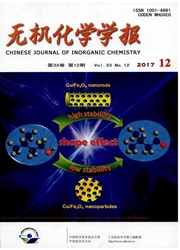

 中文摘要:
中文摘要:
以Co(Ac)24H2O和六次甲基四胺(HMTA)为起始反应物,聚氧乙烯-聚氧丙烯-聚氧乙烯(P123)为表面活性剂,在乙二醇(EG)和水混合溶剂中用溶剂热法得到中间产物,通过煅烧热处理制备了Co3O4纳米片。利用XRD、SEM和N2吸附-脱附等方法进行了样品表征,研究了不同热处理温度对产物形貌和结晶度的影响,以及所制备纳米片的气敏性能。根据气敏测试和吸附性能结果,分析了气敏机理和吸附动力学。结果表明:热处理温度是影响产物形貌的关键因素,350℃是最佳的热处理温度,此时得到的纳米片最薄也最均匀。由于产物形貌变化改变了材料的比表面积,进而影响到产物的气敏性能和吸附性能。总体而言,纳米片厚度越小,比表面积越大,材料的气敏灵敏度和吸附效率越高。
 英文摘要:
英文摘要:
Co3O4 nanosheets with different thickness were synthesized by calcinating the precursors obtained from solvothermal synthesis using Co(Ac)24H2O and HMTA as reactants, P123 as surfactant, EG and H2O mixture as solvent. The samples were characterized by XRD, SEM and N2 adsorption-desorption measurement. Influence of calcination temperature on the morphology and crystallinity was studied; gas-sensing performance of the samples was also measured. The gas-sensing mechanism and the adsorption kinetic were analyzed according to the results of gas sensor tests and the adsorption experiments. Results show that the calcination temperature is a key factor influencing the sample morphology. The best uniform thin nanosheets were obtained at 350℃, which is selected as the optimum heat treatment temperature. Different heat treatment temperatures result in the change of specific surface area, hereafter the gas sensing and adsorption performance. In general, the smaller the nanosheets thickness, the bigger the specific surface area, the higher the gas sensing response and the adsorption efficiency.
 同期刊论文项目
同期刊论文项目
 同项目期刊论文
同项目期刊论文
 期刊信息
期刊信息
